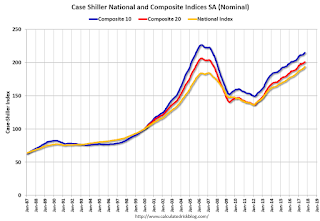by Calculated Risk on 11/28/2017 09:13:00 AM
Tuesday, November 28, 2017
Case-Shiller: National House Price Index increased 6.2% year-over-year in September
S&P/Case-Shiller released the monthly Home Price Indices for September ("September" is a 3 month average of July, August and September prices).
This release includes prices for 20 individual cities, two composite indices (for 10 cities and 20 cities) and the monthly National index.
Note: Case-Shiller reports Not Seasonally Adjusted (NSA), I use the SA data for the graphs.
From S&P: September S&P CoreLogic Case-Shiller National Home Price NSA Index Up 6.2% In Last 12 Months
The S&P CoreLogic Case-Shiller U.S. National Home Price NSA Index, covering all nine U.S. census divisions, reported a 6.2% annual gain in September, up from 5.9% in the previous month. The 10-City Composite annual increase came in at 5.7%, up from 5.2% the previous month. The 20-City Composite posted a 6.2% year-over-year gain, up from 5.8% the previous month.
Seattle, Las Vegas, and San Diego reported the highest year-over-year gains among the 20 cities. In September, Seattle led the way with a 12.9% year-over-year price increase, followed by Las Vegas with a 9.0% increase, and San Diego with an 8.2% increase. 13 cities reported greater price increases in the year ending September 2017 versus the year ending August 2017.
...
Before seasonal adjustment, the National Index posted a month-over-month gain of 0.4% in September. The 10-City and 20-City Composites reported increases of 0.5% and 0.4%, respectively. After seasonal adjustment, the National Index recorded a 0.7% month-over-month increase in September. The 10-City and 20-City Composites posted 0.6% and 0.5% month-over-month increases, respectively. 15 of 20 cities reported increases in September before seasonal adjustment, while all 20 cities reported increases after seasonal adjustment.
“Home prices continued to rise across the country with the S&P CoreLogic Case-Shiller National Index rising at the fastest annual rate since June 2014,” says David M. Blitzer, Managing Director and Chairman of the Index Committee at S&P Dow Jones Indices. “Home prices were higher in all 20 cities tracked by these indices compared to a year earlier; 16 cities saw annual price increases accelerate from last month. Strength continues to be concentrated in the west with Seattle, Las Vegas, San Diego and Portland seeing the largest gains. The smallest increases were in Atlanta, New York, Miami, Chicago and Washington. Eight cities have surpassed their pre-financial crisis peaks.”
“Most economic indicators suggest that home prices can see further gains. Rental rates and home prices are climbing, the rent-to-buy ratio remains stable, the average rate on a 30-year mortgage is still under 4%, and at a 3.8-month supply, the inventory of homes for sale is still low. The overall economy is growing with the unemployment rate at 4.1%, inflation at 2% and wages rising at 3% or more. One dark cloud for housing is affordability – rising prices mean that some people will be squeezed out of the market.”
emphasis added
 Click on graph for larger image.
Click on graph for larger image. The first graph shows the nominal seasonally adjusted Composite 10, Composite 20 and National indices (the Composite 20 was started in January 2000).
The Composite 10 index is off 5.3% from the peak, and up 0.6% in September (SA).
The Composite 20 index is off 2.6% from the peak, and up 0.5% (SA) in September.
The National index is 5.1% above the bubble peak (SA), and up 0.7% (SA) in September. The National index is up 42.1% from the post-bubble low set in December 2011 (SA).
 The second graph shows the Year over year change in all three indices.
The second graph shows the Year over year change in all three indices.The Composite 10 SA is up 5.7% compared to September 2016. The Composite 20 SA is up 6.2% year-over-year.
The National index SA is up 6.2% year-over-year.
Note: According to the data, prices increased in all 20 of 20 cities month-over-month seasonally adjusted.
I'll have more later.


